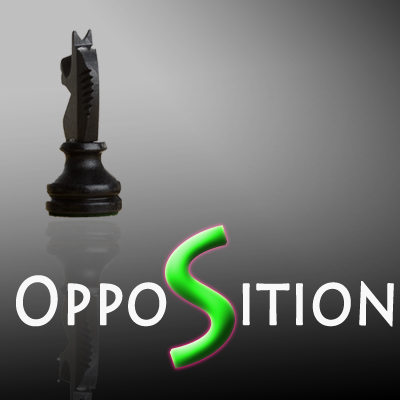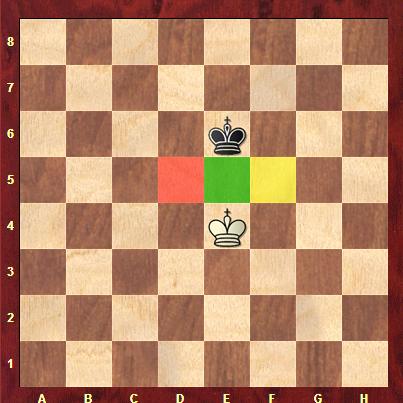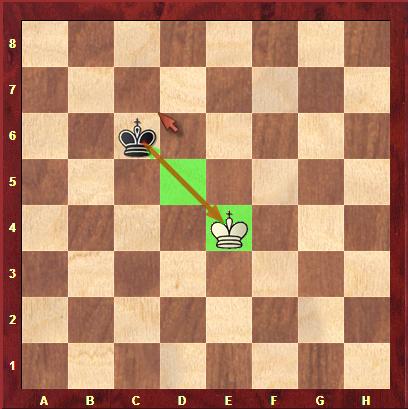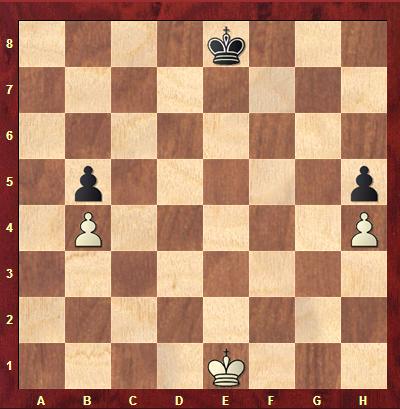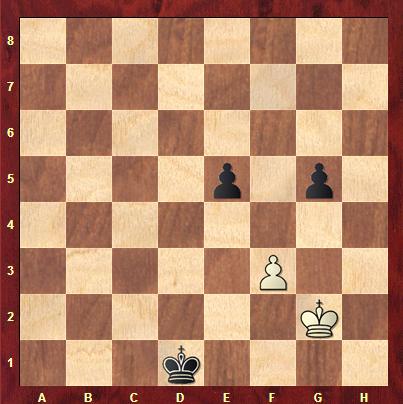The Power of Pawn – Pawn Promotions
In this brief article we will go over some situations where you can end up in pawn ending game. Pawn ending games are always the trickiest part for beginners as they always end up playing it wrong.One important tip to remember when in a pawn ending game is that the King should be in front of his pawn, with at least one intervening square.
(Example 1)

Pawn Promotion – 1 pawn vs 0 pawn
One of the most important endgame position, the whole sequence of moves are important and you must familiarize yourself with the procedure. The reason behind learning the position really well is that, this principle will help you learn the more advance variations of such position. Every beginner should study this position until they can play the moves without any trouble. I cannot stress enough how important is the given position. As mentioned earlier for any such endgame to be won the king must be in front of the pawn, in this example the game is drawn because white king is not in front of the pawn with at least one intervening square and thus there is no way that white can promote the pawn.
(Example 2)

Pawn Promotion – 1 pawn vs 0 pawn cont.
In this position white is winning given it knows what to do. The strategy to follow is not that difficult the idea is to move the king as far as is compatible with the safety of the pawn and never to advance the pawn until it is essential to its own safety.
The ending is similar to the last one, but in this one white wins and you must study the position thoroughly and practice it as many times as possible to master the sequence of moves because the position can arrive on any side of the board and in many different manners. Thus it is essential to master the moves and then try to over the moves every now and then until the idea is grasped and digested.
A simple sequence of moves to win the position would be as follows –
1.Ke4 Ke6
2.e3 Kf6
3.Kd5 Kf5
4.e4+ Kf6
5.Kd6 Kf7
6.e5 Ke8
7.Ke6
Now no matter where black moves white can secure either f7 or d7 and then promote the pawn to a queen.
(Example 3)

Pawn Promotion – 2 pawns vs 1 pawn
Now we shall move to some more pawn endings these will be bit advanced and thus will require more time to digest than the first ones, but the idea remains the same. Best way to learn these methods would be to practice and practice, this article can only guide you and the rest should be done through practice.
From the diagram above at first glance it may seem easy but these situations can be very daunting to new players and most games can end up in a draw. For example in the given position the best way for white would be to play the following moves –
1.Kd7 Kg8
2.Ke7 Kh8
3.f6 gxf6
4.Kf7 f5
5.g7+ Kh7
6.g8Q+ Kh6
7.Qg6#
As you can see at first glance it may look difficult but with practice it can become a lot more easier, you just remember the basic ideas. In this case we know that king has to be cornered and then give up the pawn in order to push the g pawn and then promote it to queen and then mate is followed. Again you must practice the position good number of times so that you know it inside out and can apply the moves in a real game.
Lets look at another position which can also be very easy but can be very daunting to some beginners and most of them do make mistakes when they end up in a position as such.
(Example 4)

In the following position white cannot win if he/she plays f5 because then black will play g6 and then the game is a dull draw. Same goes for g5 because then again black will move g6 and it is a draw. In this position the best move is Ke4 and then black plays Ke6 you may be wondering why not g6, well if black plays g6 then (kd4 Ke6 Kc5 Kf6 Kd6 Kf7 g5 Kg7 Ke7 Kg8 Kf6 Kh7 and Kf7 wins the pawn) and that is why Ke6 is a better move.
After Ke4 Ke6, the next best move for white is f5+ Kf6 and then Kf4 g6 and after that a series of moves such as 1.g5+ Kf7 2.f6 Ke6 3.Ke4 Kf7 4.Ke5 Kf8 and now white has to give the f pawn in order to get into a position so that the win can come by easily in this case by giving the f pawn white forces the king to capture it and then corner it and win the g pawn and queen its own g pawn. The moves are as followed after Kf8.
1. f7 Kxf7
2. Kd6 Kf8
3. Ke6 Kg7
4. Ke7 Kg8
5. Kf6 Kh7
6. Kf7 Kh8
7. Kxg6 Kg8
8. Kh6 Kh8
9. g6 Kg8
10. g7 Kf7
11. Kh7
And now white will promote the pawn to queen and the mate to follow.
(Example 5)

Pawn Promotion – 3 pawns vs 2 pawns
In this position white can either move f5 or h5 or Ke4. But a simple procedure would be as follows.
1.f5 Ke7
2.Ke5 Kf7
3.g5 Ke7
4.h5 g6
5.hxg6 hxg6
6.f6+
In this position if g6 or f6 is played earlier then one of the earlier positions will come into play by now you should have good idea of some basic positions if you learn the basics then the it will be easier to grasp the other one as well.
(Example 6)

Pawn Promotion – 3 pawns vs 2 pawns Contd
After doing some basics lets move to some other variations of the same positions with pawns vs pawns ending. This time around with pawns on other sides of the board. In a situation like such the general rule of thumb is that you must move your king to the side of the board where you have stronger forces in other words where you have more pawns. But as mentioned before if played incorrectly this winning position can turn into a draw.
Combination of moves to win the game would be the following. Remember the basic idea you move on the side of the board with stronger forces. And then once the king is pushed you can move the king to other side of the board and then win.
1.g4 a5
2.a4 Kf6 (in this position after black has played a5 it is best to move a4 just in case things go wrong the other side you will have the pawn already half way through to move.)
3.h4 Ke6
4.g5 Kf7
5.Kf5 Kg7
6.h5 Kf7
7.Ke5 Kg8
8.g6 h6
9.Kd5 Kg7
Now no matter what white wins so the white king can move to the left side of the board and capture the a pawn if the black king tries to capture white h pawn then the g pawn will move and there is no way to stop it. In this position things can get nasty so always make sure that you have control on one side of the board before moving to the other side.
